1lumen selects and reviews products personally. We may earn affiliate commissions through our links, which help support our testing.
Thrunite Catapult Mini review
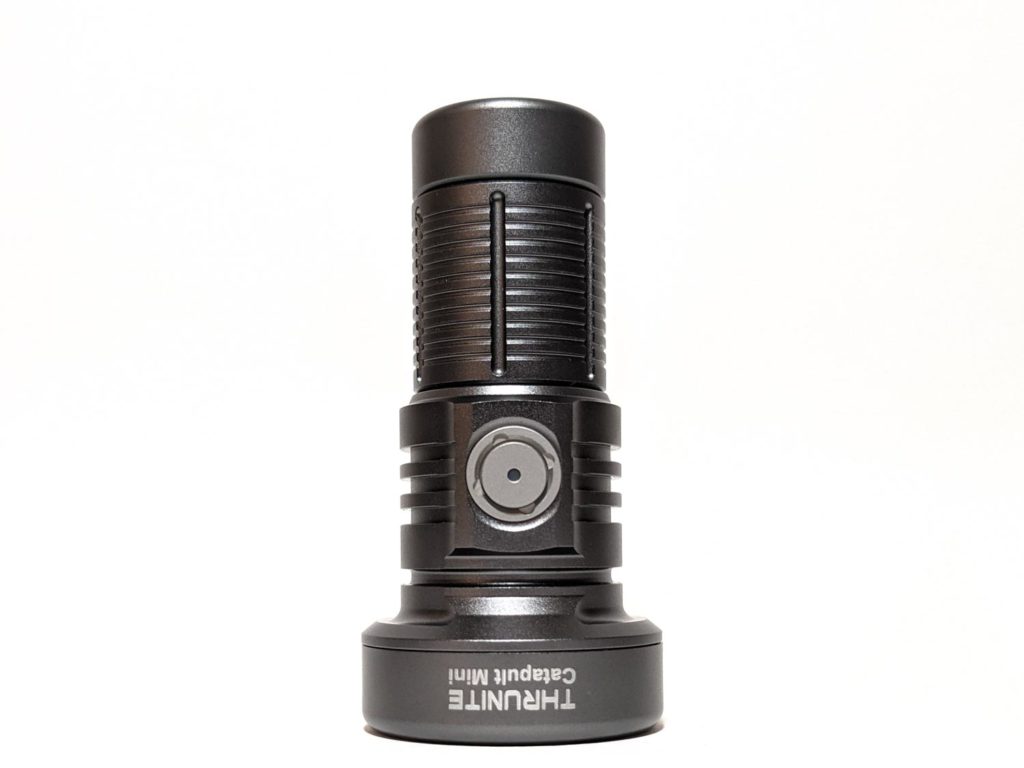
Thrunite Catapult Mini specifications
| Brand/model | Thrunite Catapult Mini |
|---|---|
| LED | Osram KW CSLNM1.TG |
| Lumens | 680 lm |
| Beam intensity | 89,600 cd |
| Battery config. | 1*18350 |
| Material | Aluminum |
| Modes | 5 |
| Blinkies | Strobe, beacon, SOS |
| Reflector | TIR optic |
| Waterproof | IPX8 |
| Review date | July 2021 |
Introduction:
Thrunite’s medium-sized thrower, the Catapult V6, has been a long time staple in the flashlight market. Now they’ve released a mini version called, you guessed it, the Catapult Mini! This is the latest (and smallest) light to be released in the compact TIR thrower category. It uses an electronic side switch, Osram emitter, 18350 battery, and of course that big ol’ TIR optic.
Package quality.
Thrunite did an excellent job on the packaging for the Catapult Mini. It comes in a small cardboard box with a lid that slides off (like a board game box). It’s quite sturdy and has minimal Thrunite branding on it indicating the model of the light. Inside is a nice open cell foam insert to keep the light protected during transit. They put money where it counts and didn’t waste any on fancy printing or magnetic closures.
- The flashlight: Thrunite Catapult Mini
- Proprietary 18350 battery (inside the light)
- 12” USB charging cable (A to C)
- User manual
- Two spare o-rings
- Thrunite branded lanyard
- Spare charging port cover
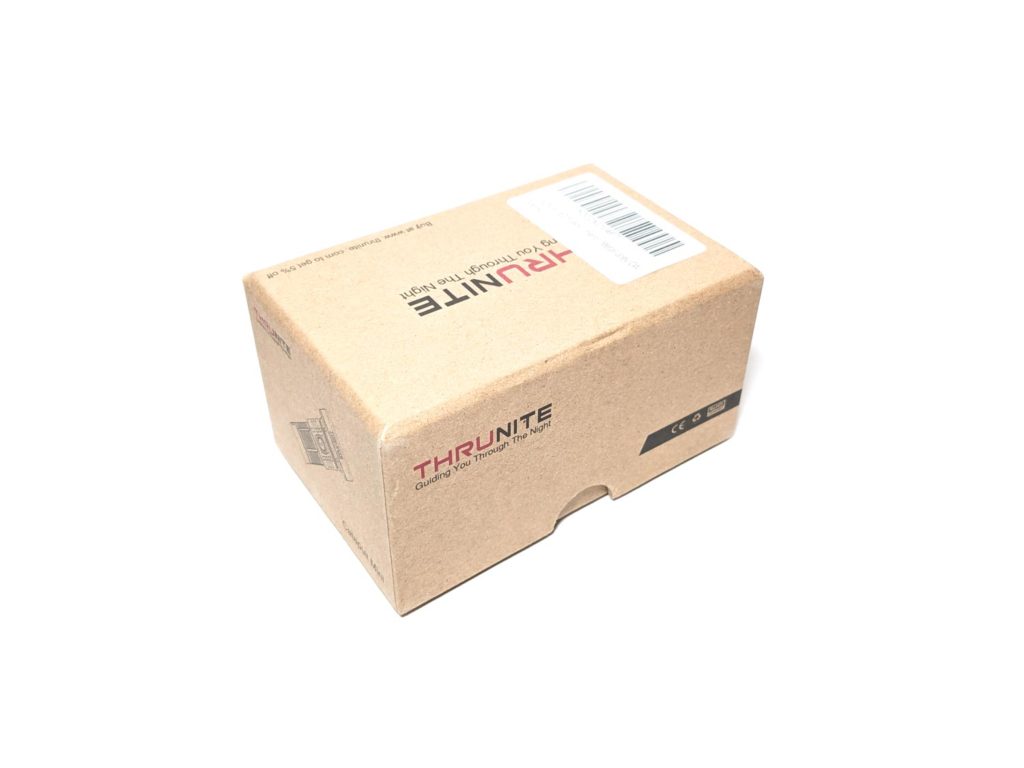
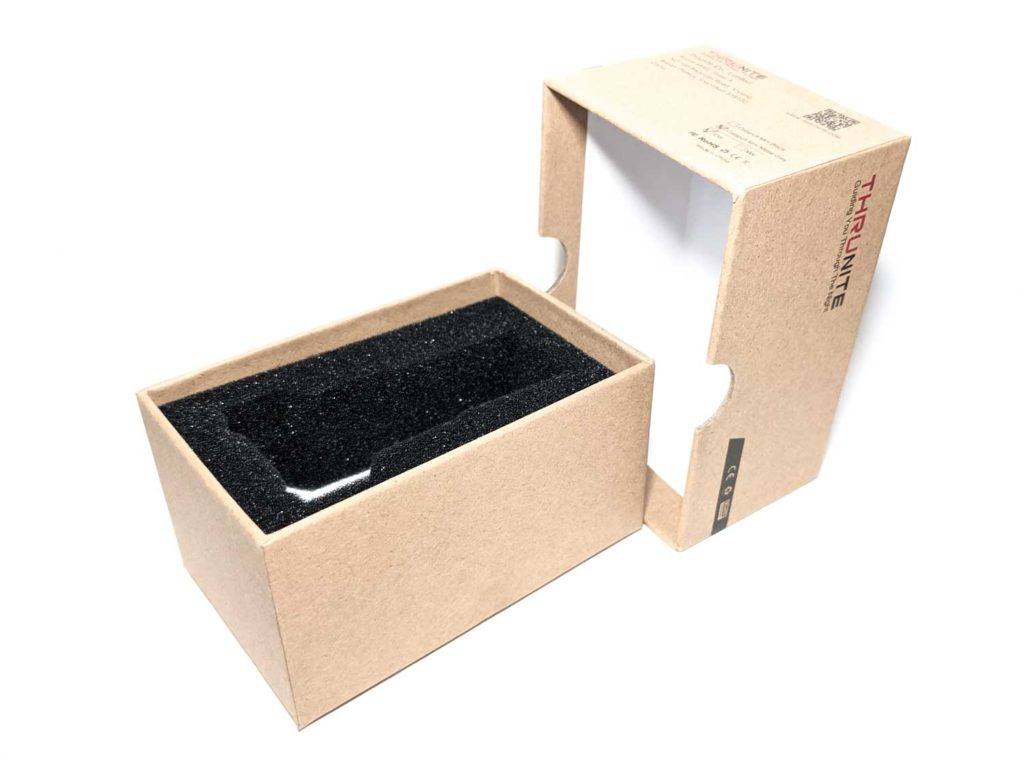
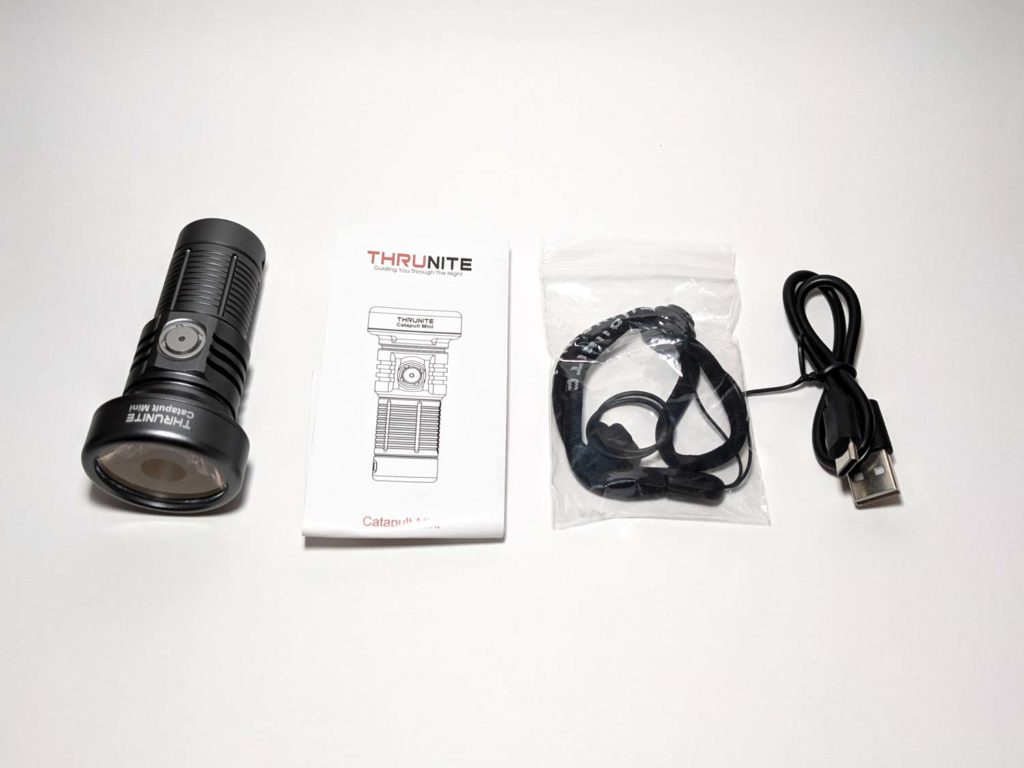
Flashlight in use
The Catapult Mini is tiny. It’s got a decent amount of texturing and grip to it, but it’s so short that in a normal grip I can’t quite get a firm hold on it. Holding it like a pen and using my index finger to actuate the switch makes it feel a little more secure. Installing the lanyard gives you a lot more to hold onto even if it’s not wrapped around your wrist.
Thrunite used an electronic side switch with a hard (probably plastic) boot and a central indicator LED. The LED glows for a few seconds after you turn on the light. Red means the battery is low, blue means it’s not low.
It’s easy to fit in a pocket, though you feel it since the head is a little wide. I really would have liked to see a pocket clip included. It’s not a light I would use for EDC, but a pocket clip would allow me to quickly stow it in a pocket or clip it to a strap without risking it falling out or being scratched by other objects in the same pocket. I found that Lumintop FW3A clips fit nicely between the tailcap and the body tube. You just have to fold over some aluminum foil and put it between them to make sure there’s an electrical connection.
There are no anti-roll cuts so it rolls freely on a flat surface. The flared head makes it roll in a circle though so it won’t roll indefinitely, but it still rolls far enough to be a problem. I would have preferred there be some kind of anti-roll feature included (like a pocket clip).
Tailstanding works well. It’s especially fun to tailstand at night in moonlight mode because it makes the room look like there’s actual moonlight coming from the hotspot on the ceiling.
There’s a lanyard hole on the tailcap that works well. It’s in the side of the tailcap instead of in the corner so it doesn’t create a hotspot when you’re holding the light.
The included lanyard attaches easily & securely. It provides a lot of extra grip for the light even without attaching it to your wrist.
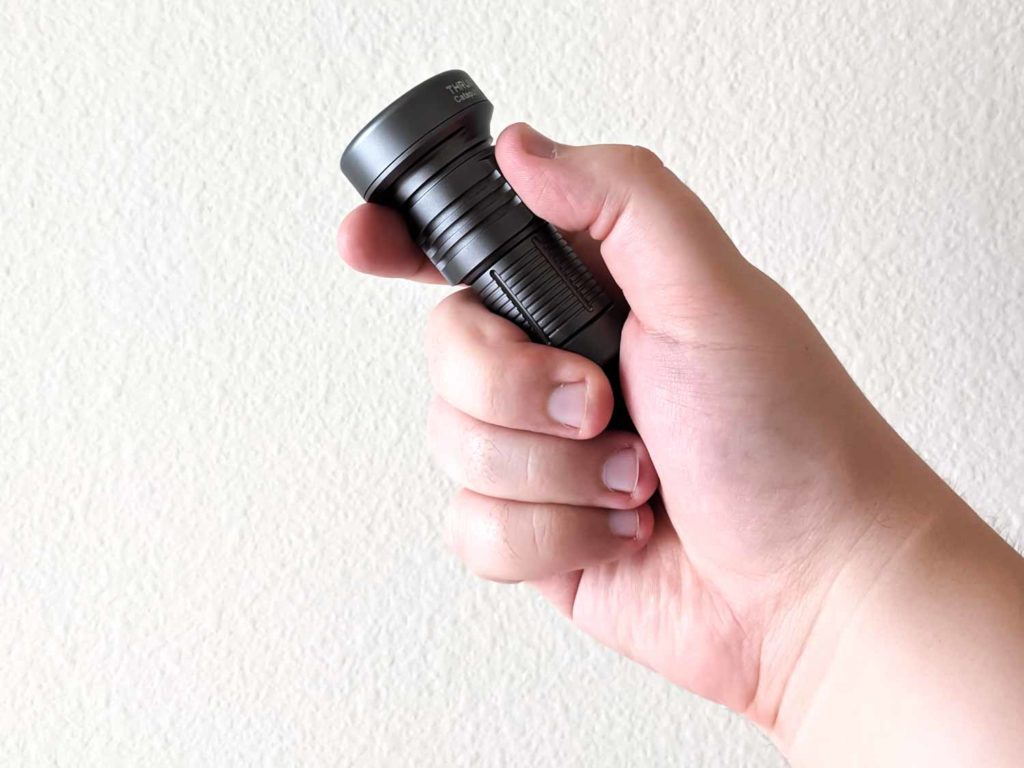
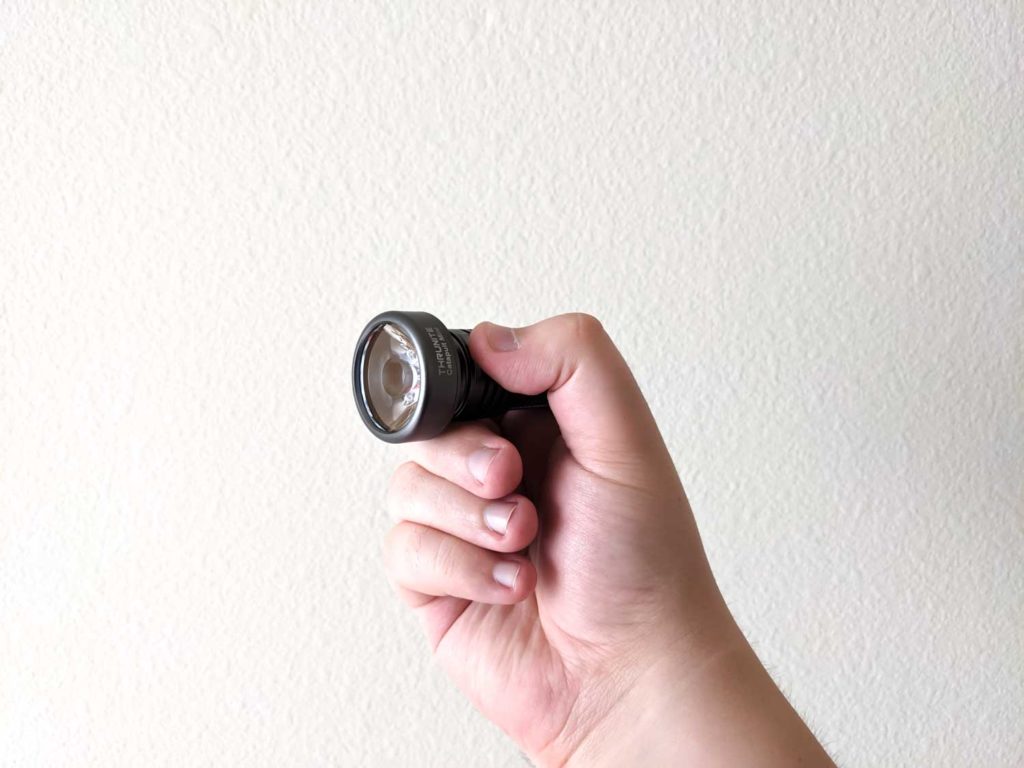
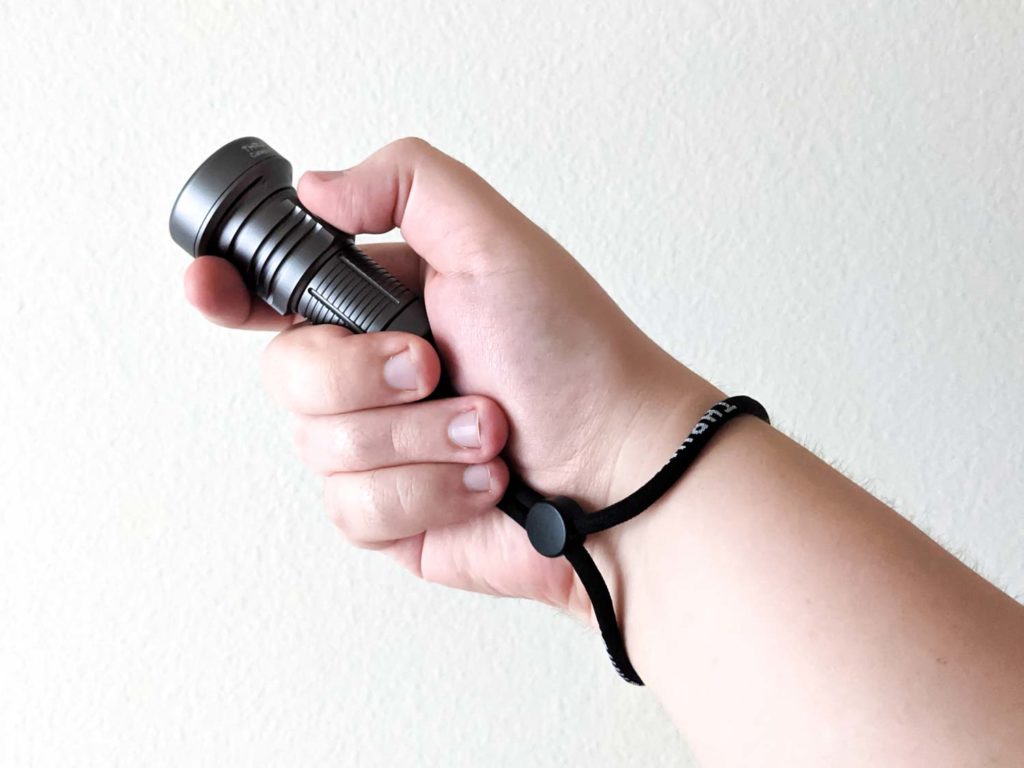
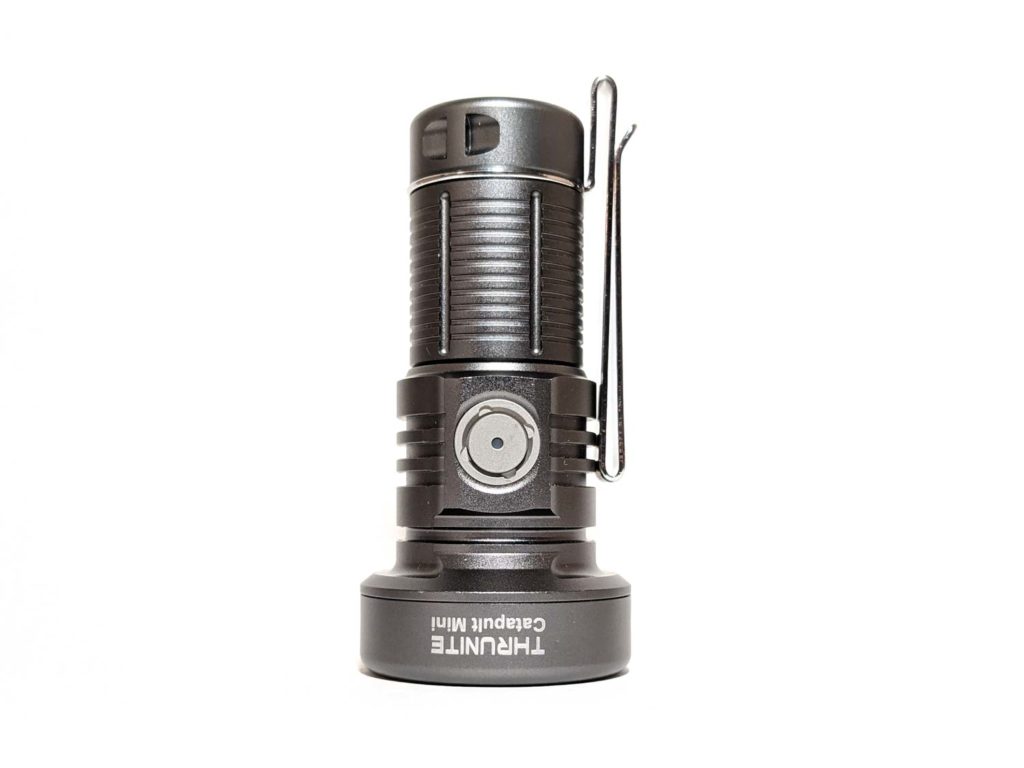
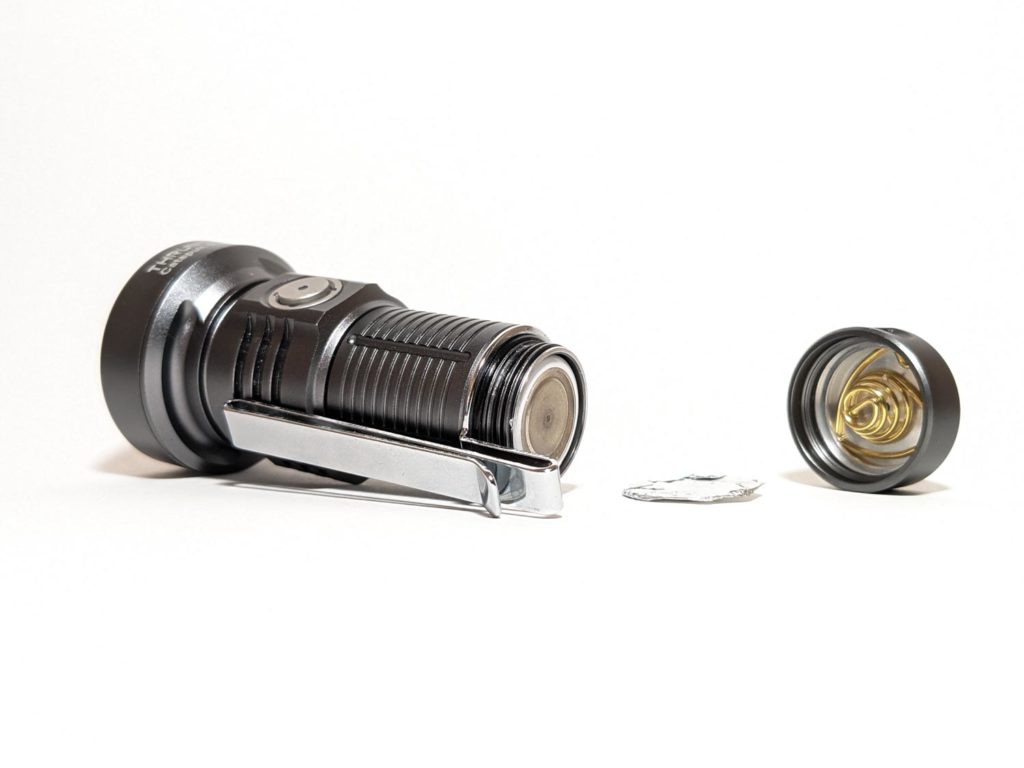
Build Quality, and Warranty
The machining is excellent as I would expect from Thrunite. There’s no knurling but there’s a nice milling pattern on the body tube. It’s not especially grippy but it’s better than smooth aluminum.
The tailcap is short, rounded, and smooth. I found removing the body tube from the head to be the easiest way to remove the battery since it’s harder to get a grip on the tailcap. Mechanical lockout works either way.
It’s made of anodized aluminum in an attractive grey color. I haven’t used any other lights with this particular shade of anodizing. It looks and feels great. Black is also available.
The threads are square cut, smooth, and conservatively but sufficiently lubricated. They’re noticeably short and they can be a little difficult to line up and get started sometimes. Overall they’re satisfactory.
The included lanyard is high quality and has some Thrunite branding on it. I’m not a big lanyard guy but this is one of the nicer ones I’ve used.
The positive contact on the driver board is a small brass button. The negative contact is a big, beefy gold-plated spring.
Warranty: If you buy directly from Thrunite or through their Amazon store, you can return the light for a refund if it’s in new condition within 30 days of purchase. If your light has manufacturing or workmanship related problems within 2 years of purchase, Thrunite may replace it. After 2 years, they will still perform repair or replacement work at the cost of the customer.
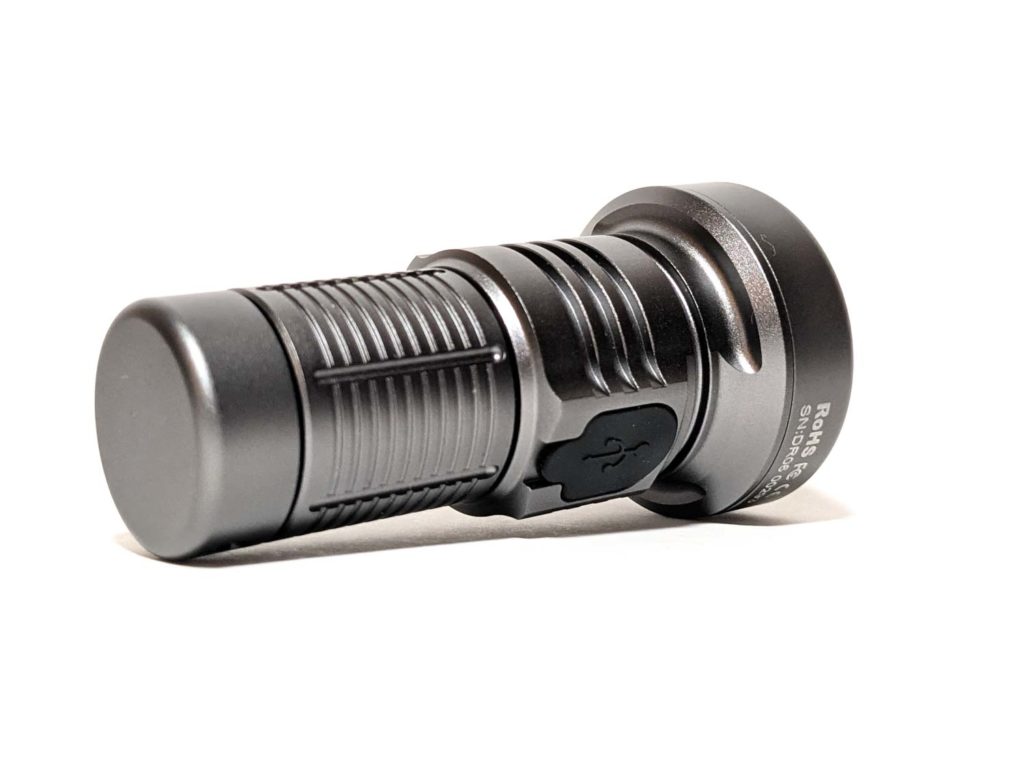
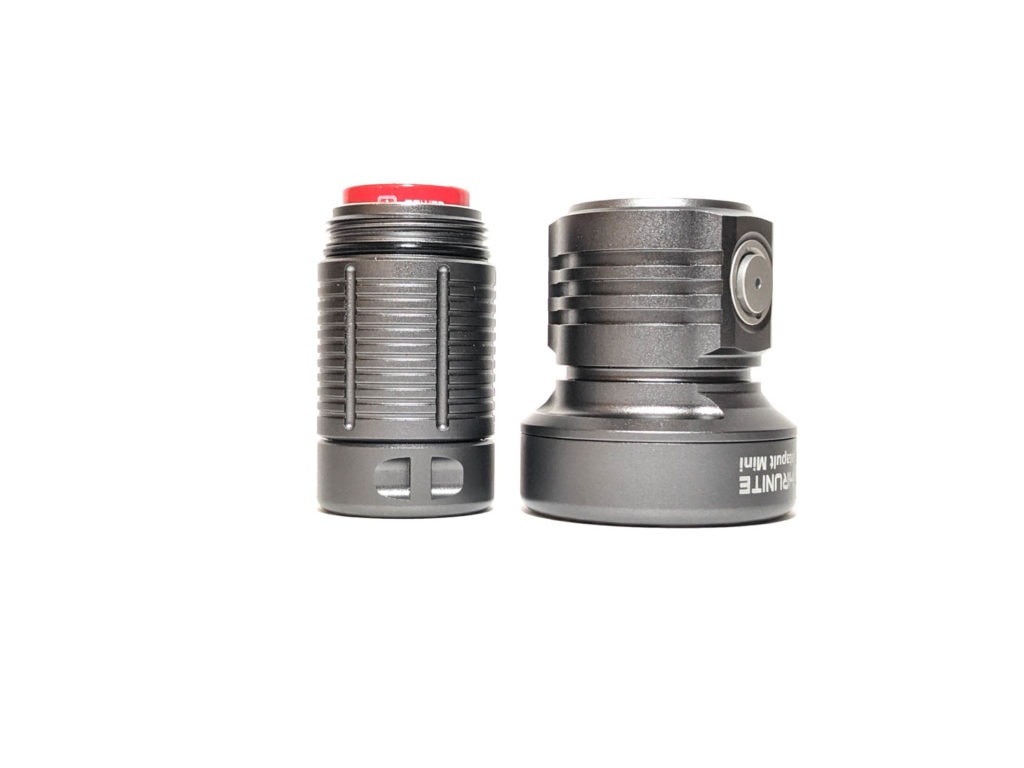
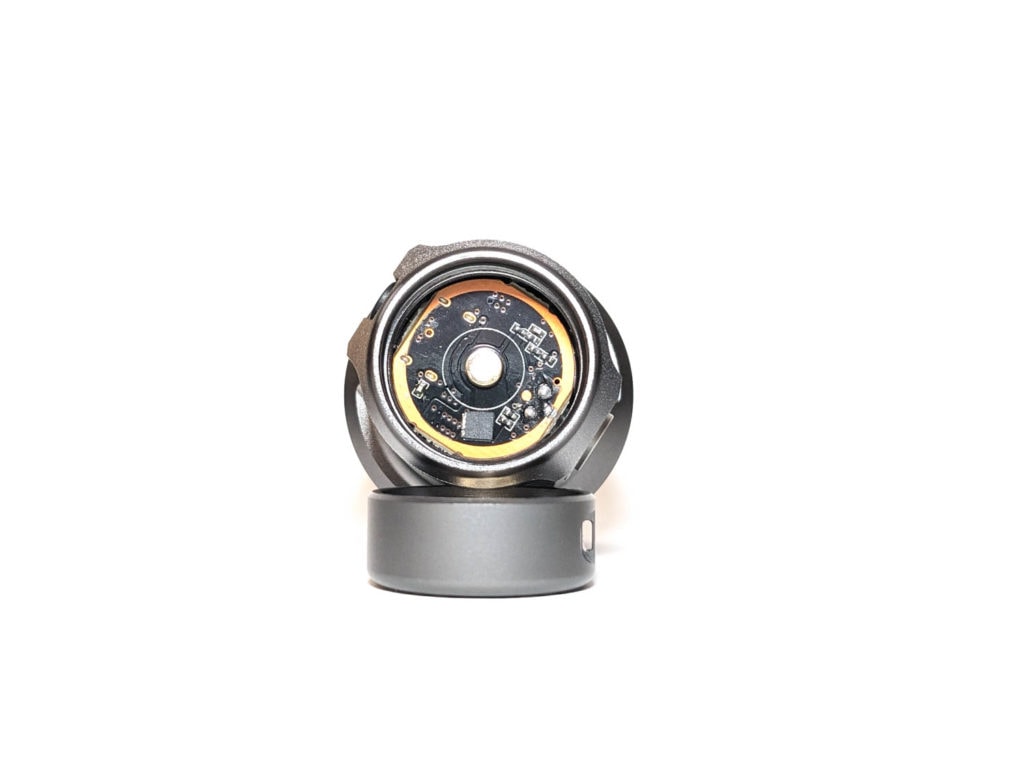
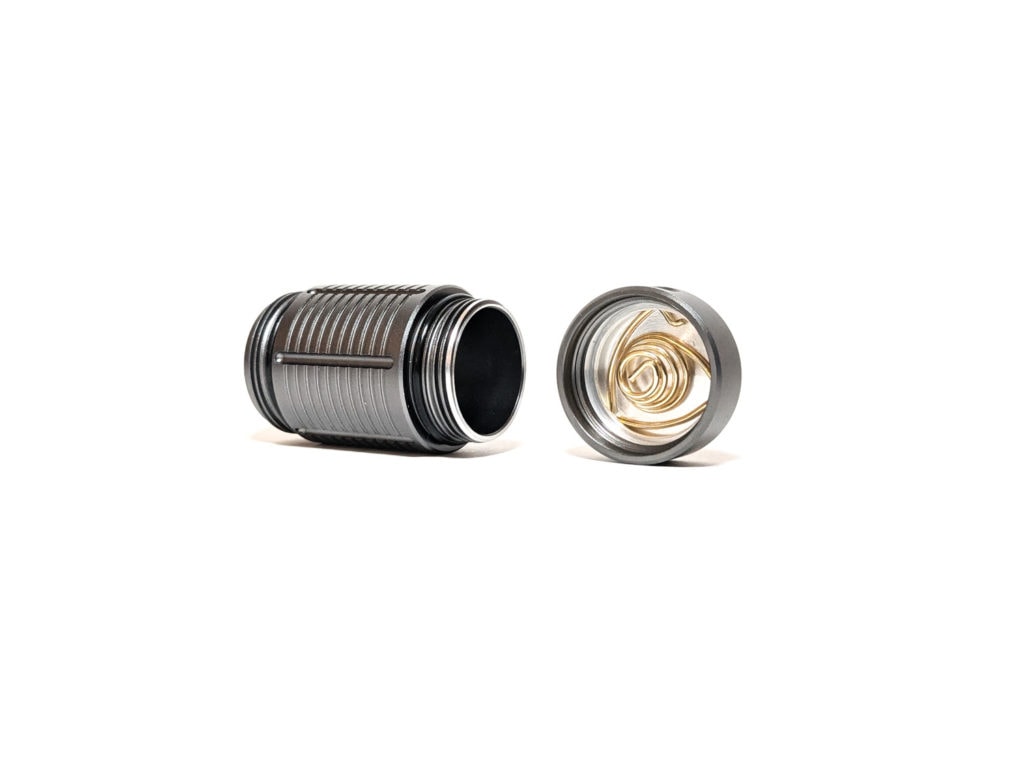
LED, Lens, Bezel, and Reflector
The Catapult Mini uses an Osram CSLNM1.TG emitter. It’s a 3030 footprint domeless emitter with a 1 square millimeter die, originally designed for projectors. That tiny die gives it incredibly high intensity for great throw.
Thrunite has “Neutral White” as a color temperature listed on their site that’s greyed out, but I haven’t ever seen any color temp of CSLNM1 except for 6000K so I do not expect there to ever actually be a neutral white option.
Instead of a reflector, Thrunite used a large TIR optic for the catapult mini. It’s the same optic used in all the other compact TIR throwers like the Acebeam L17, E10, Manker MC13, Lumintop FW21 X1L, and Astrolux EA01.
It produces a remarkably tight beam for how small the light is. The hotspot is bright and well defined. The spill looks different than any reflector based light though. It’s very dim and doesn’t have a definitive cutoff. It just slowly fades as you get further away from the hotspot. I believe it comes from the small diffused section in the middle of the optic.
The bezel is anodized aluminum and is nicely rounded on the front.
The Catapult Mini is decidedly built for long-range use. Up close the hotspot is way too small and bright. The spill is way too dim. Up close all you see is a narrow hotspot and it’s only useful for pointing at things.
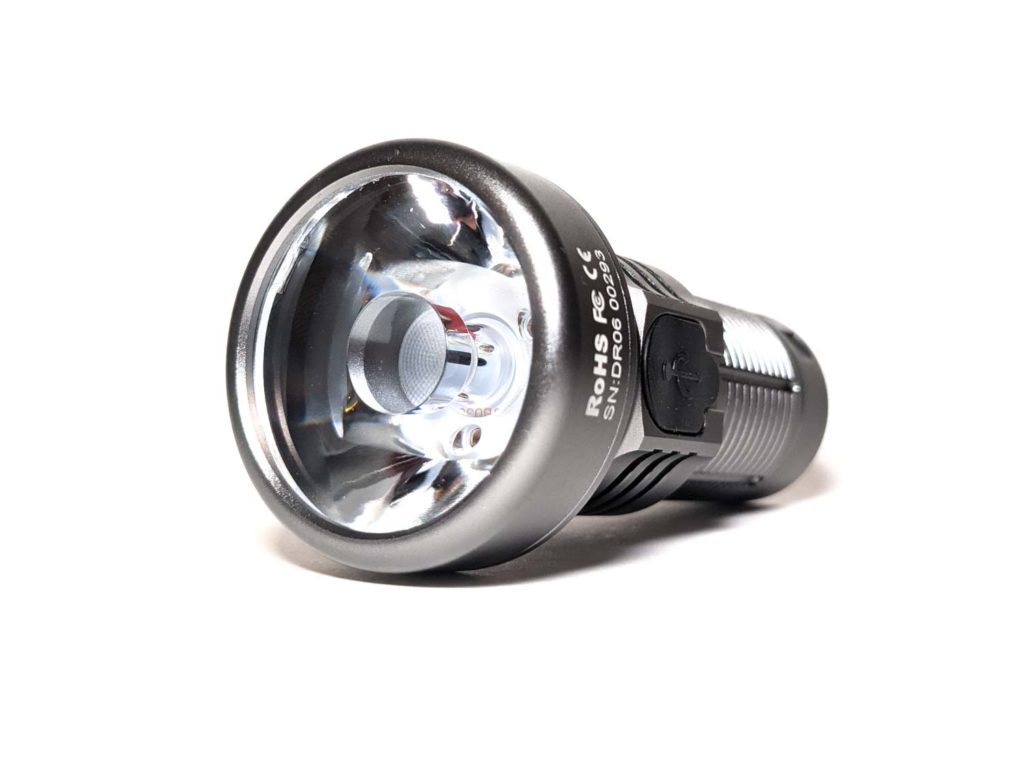
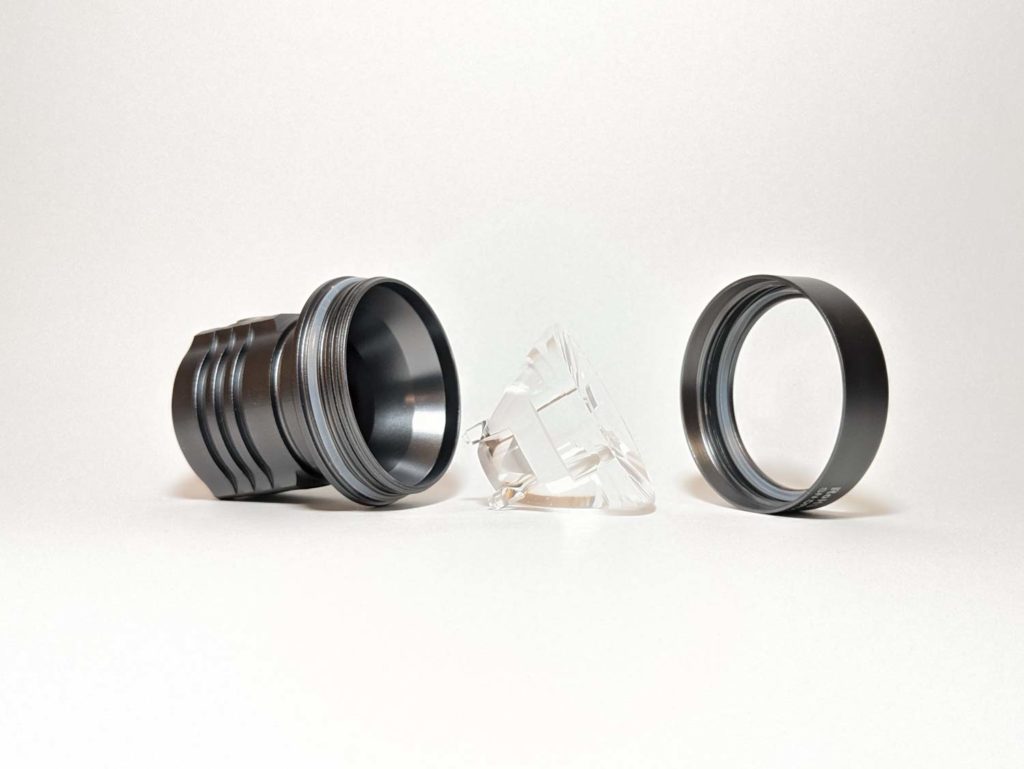
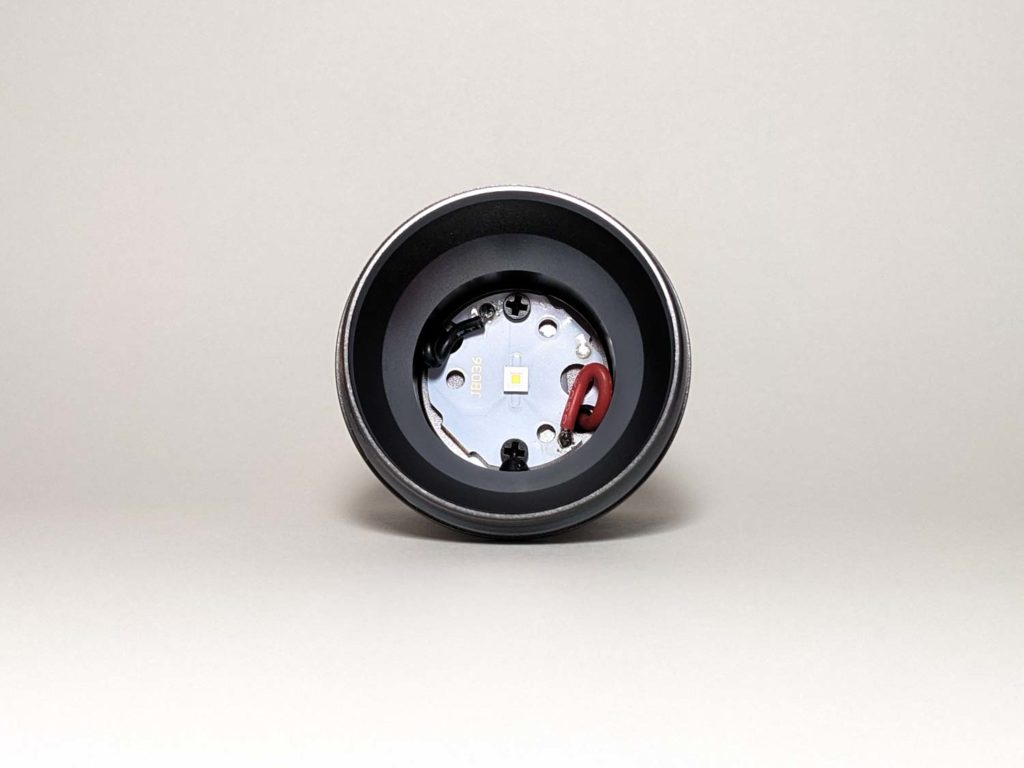
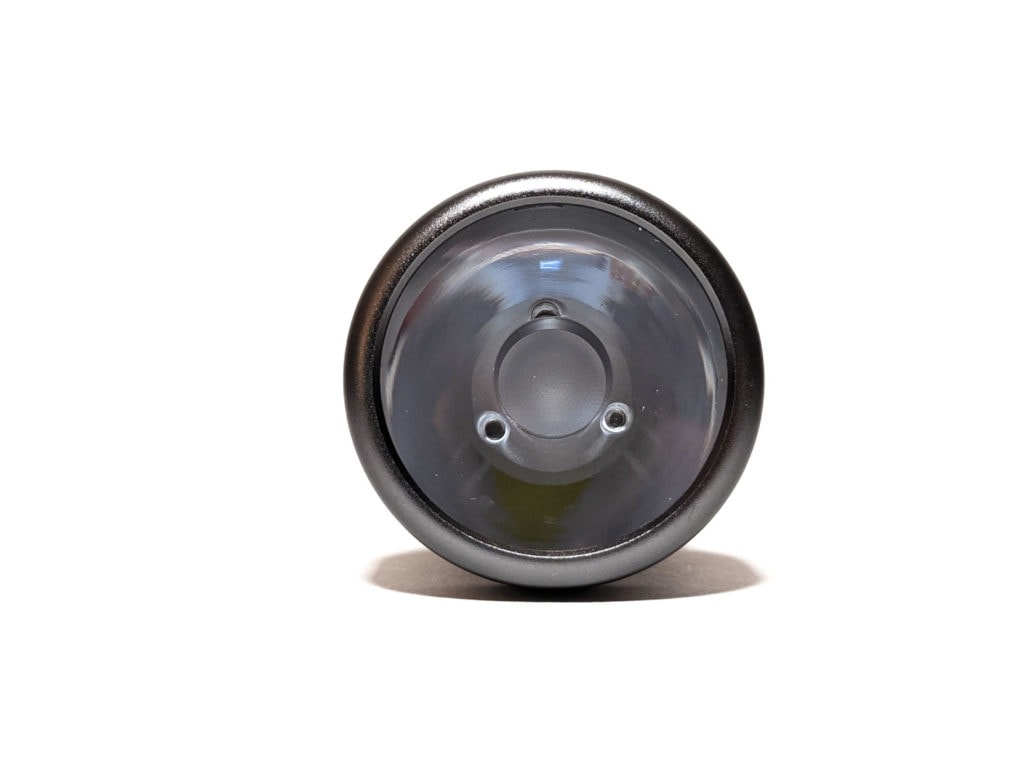
Dimensions and size comparison
- Length: 8.15cm / 3.21in
- Head diameter: 4.04cm / 1.59inches
- Body diameter: 2.6cm / 1.02inches
Weight:
- With cells: Officially 116.6g / 4.11oz
Thrower Flashlight comparison
The Catapult Mini falls into the Compact or EDC Thrower category, with lights like the Noctigon KR1 and other compact TIR throwers. Here is a comparison with a few other EDC sized lights.
From left to right: Noctigon KR1, Thrunite Catapult Mini, Emisar D4V2, Skilhunt H04 RC

Driver & User Interface:
Modes: Moonlight, Low, Medium, High, Turbo, Strobe, and Lockout
From OFF:
- Press and Hold (1-2 seconds): Moonlight
- Press and Hold (>2 seconds): Moonlight, then off and temporary lockout (until switch is pressed again)
- Single click: On (mode memory, except Moonlight, Turbo, and Strobe)
- Double click: Turbo
- Triple click: Strobe
- 4 clicks: Lockout (blinks 3x to confirm)
From ON:
- Press and Hold (from Moonlight): Low
- Press and Hold (from Turbo): Memorized mode
- Press and Hold (from normal mode): Next mode (low-med-high)
- Single click: Off
- Double click (from anything except Turbo): Turbo
- Double click (from Turbo): Memorized mode
- Triple click: Strobe
- 4+ clicks: same as triple click
From Blinkies
- Press and Hold: Next blinky mode (strobe-beacon-sos)
- Single click: Off
- Double Click: Turbo
From Lockout:
- 4 clicks: Unlock to memorized mode
- 1 click: switch blinks
Mode memory:
- Yes, only Low, Medium, and High
Shortcuts:
- To Moonlight: hold from off
- To Turbo: double click from off
- To Strobe: triple click from off
Low voltage warning:
- When cell voltage is low, the indicator LED on the button will turn red. When cell voltage is REALLY low, the light will step down to moonlight mode.
Strobe/blinkies
- Strobe, accessed via triple click
Lock-out mode:
- Lockout is activated or deactivated by a quadruple click
PWM
- I can’t detect any PWM with my eyes on any mode.
Additional info on the UI:
- This UI is pretty excellent. It’s my favorite E-switch UI I’ve used besides Anduril. I REALLY like that neither Moonlight nor Turbo are memorized into mode memory. That means that from off I effectively have THREE shortcuts: one to moonlight, one to turbo, and one to the memorized mode. I also really appreciate the ability to jump from moonlight to low, and from turbo back to the memorized mode.
- I do have a few very minor grips and changes I’d like to see in a Catapult Mini V2. I missed having an actual voltage readout mode rather than just the LED indicator so I can get a more precise idea of how much battery is left. I also think a momentary mode would be useful. You can kind of use the body tube as a momentary tail switch by unscrewing it ever so slightly and pressing on it because the light will come back on in the memorized mode after a battery tube disconnection. It’s not the most reliable method though.
Batteries & Charging
The included battery is a Thrunite branded, proprietary, 1100mah, protected 18350 cell. It’s the kind of proprietary cell that Olight, Klarus, and a few other companies also use. The traditionally positive end has both a positive center connection and a negative connection around it. The positive connection is recessed inside a plastic ring. It’s a fairly long cell at 39.3mm.
There’s nothing about the design of the light itself that requires one of these proprietary batteries. It’s disappointing to see Thrunite include a proprietary battery even though it’s not necessary. The included cell likely won’t work in most other 18350 lights due to its proprietary positive end or excessive length. It also won’t be compatible with most bay chargers since the positive terminal is recessed in a plastic ring. Since it’s such a long cell, the battery tube seemingly had to be fairly long too and that might limit compatibility with other batteries.
A 34mm long CR123A was just too short to work. Unprotected flat top 18350’s might work. Unprotected button top 18350’s would probably work. Protected button top 18350’s will definitely work.
Charging is facilitated by a USB-C port on the side of the light opposite the button. It’s a flat cover that sits flush with the aluminum body and there’s a small cutout with a tab that allows the user to pull it open. The rubber flap is fairly well protected and secure when pressed in. I don’t expect it to come open by accident. The port is fairly recessed but all of my charging cables I tested fit just fine. Charging takes just over three hours. Unfortunately, only A-to-C cables and chargers worked. None of the C-to-C cables and chargers I used could charge the light. This lack of USB-C compliance is as disappointing as the inclusion of the proprietary battery and it limits the versatility of the light.
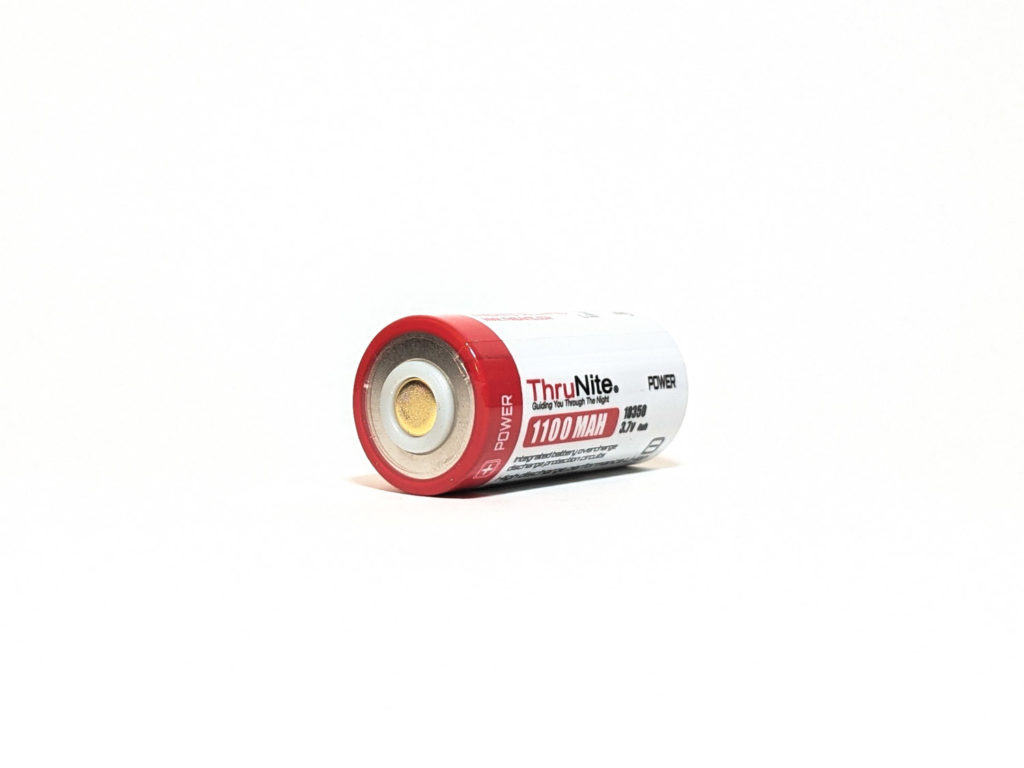
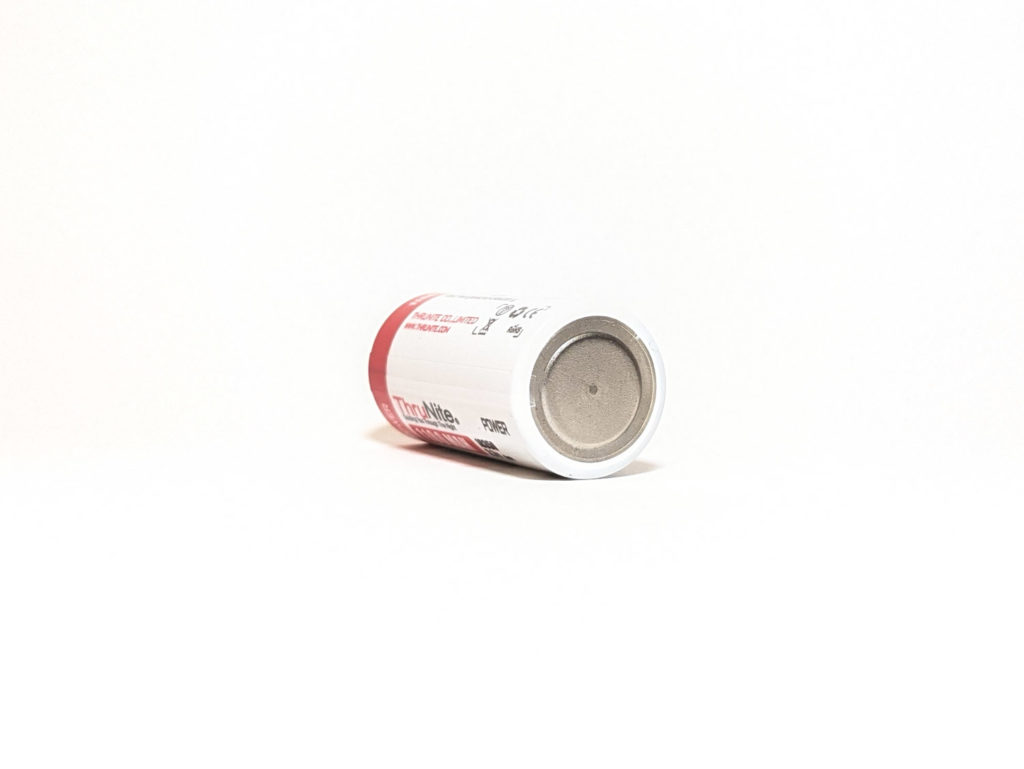
Performance
Amp measurement
Current measurements were taken with a basic digital multimeter I got online.
- Moonlight: 9.25 milliamps
- Low: 107.8 milliamps
- Med: 260 milliamps
- High: 620 milliamps
- Turbo: 2,650 milliamps
Parasitic drain:
- 13µA
Initially, the light read 4.6 milliamps, which is remarkably high for parasitic drain. However, that drops to a mere 13 microamps after 10 seconds which is more than reasonable.
Runtime graph
All runtime tests were performed using the included battery and end when the light shuts off. Testing was done with the Ceilingbounce app on a Google Pixel 4A smartphone. I used the included battery for all testing. Lumen estimates are calculated based on relative output under the assumption that turbo output is as bright as advertised.
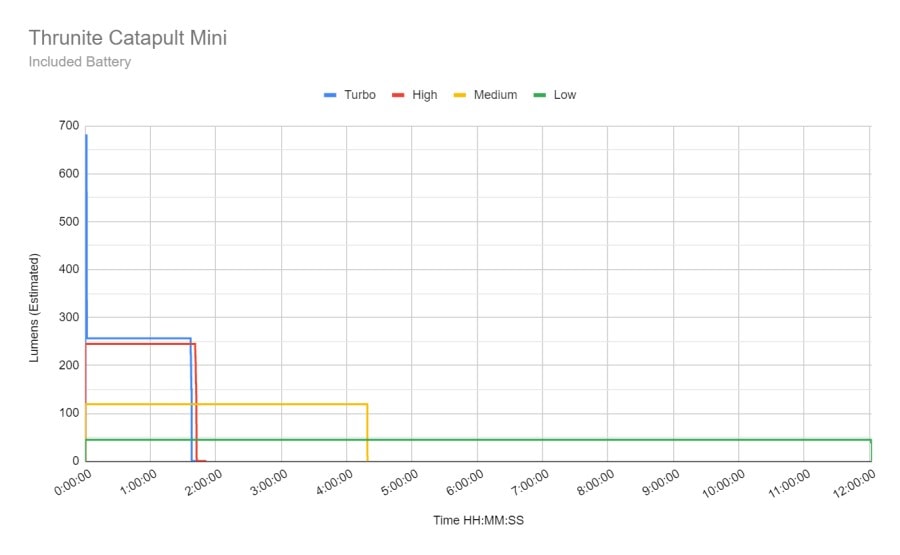
Turbo output is flat for just over a minute, then it quickly drops down to 37.7% relative output (256 lumens estimated) where it stays delightfully flat for quite some time. At 1:37 it drops to moonlight and shuts off at 1:41.
High looks almost identical to turbo except without the 1 minute turbo blip at the beginning. It runs slightly longer, dropping to moonlight at 1:41 and shutting off at 1:50. I estimate high at 245 lumens which is slightly lower than the 256 I estimated for turbo after stepdown. For all intents and purposes they are the same and that difference could just be the margin of error in my testing setup.
Medium is a perfectly flat estimated 119 lumens for a whole 4:19. I didn’t observe the short moonlight stepdown in medium mode.
Low mode again is perfectly flat and lasts an even 12 hours. Did I mention how flat all these tests are? I didn’t observe the short moonlight stepdown in low mode either.
All modes ran wonderfully flat with hard stepdowns. As far as I can tell there is zero temperature regulation in the Catapult Mini. It just runs on turbo for a minute and then steps down to high. I can get hot if I keep re-activating turbo, but just turning it on turbo one time and leaving it will only cause it to get mildly warm. Some users prefer lights to be temperature controlled as that can allow for higher sustained output. Personally I quite like the hard stepdowns and perfectly flat regulation of the Catapult Mini. It’s predictable so I always know what’s going on and what mode it’s in. The conservative output & relatively cool thermals also make this a great light to lend to someone who’s not familiar with high powered flashlights.
In every test, the light’s low voltage protection kicked in before the battery did so I was able to re-activate the light as necessary after it shut itself off. It would run for a few seconds at whatever mode I turned it on in, then dropped to moonlight, and ran at moonlight for a few minutes before turning itself off again. In my testing LVP kicked in at about 2.85V, but the cell recovered to about 3.15V after a few hours.
Lumen & throw measurements (for each mode)
I don’t have the equipment to do lumen measurements yet, so these lumen readings are calculated with the assumption that the maximum output claim of 680 lumens is accurate. I performed these measurements with the Ceilingbounce app on my Google Pixel 4A smartphone.
| Mode | Amps | Specs | 10min | 30 sec | start | Candela | Throw |
|---|---|---|---|---|---|---|---|
| Moon | 0.00925 | 0.5lm | N/A | N/A | N/A | N/A | N/A |
| Low | 0.1078 | 21 | 45 | 45 | 45 | 7,500 | 173 |
| Med | 0.26 | 96 | 119 | 119 | 119 | 20,000 | 283m |
| High | 0.62 | 235 | 245 | 245 | 245 | 40,000 | 400m |
| Turbo | 2.65 | 680 | 256 | 680* | 680* | 112,000cd | 669m |
- Moonlight: Too low to measure
- Low: 45
- Medium: 119
- High: 245
- Turbo: 680
Throw numbers:
I measured the throw using the Ceilingbounce app on my phone. I’ve verified that it’s calibrated accurately by measuring other known intensity lights and verifying that it is reading their intensity accurately. Measurements were taken at 5.7 meters.
Notably, I measured 112,000 candela which is substantially higher than the advertised 89,000 candela. It’s surprising to see a light outperforming the factory specs by that much.
Beamshots
For these beamshots I used my Google Pixel 4A smartphone.
- The most direct comparisons I have are with the Noctigon KR1 W1, Convoy Z1 CULPM1, and Acebeam E10’s.
- The KR1 appears to throw about the same distance as the Catapult Mini, but it’s got a little bit wider hotspot since the emitter is driven harder in the KR1. It’s also got significantly brighter and much more defined spill because it uses a reflector instead of a TIR.
- The Convoy Z1 throws a little further as is to be expected. The hotspots are about the same size but the Z1’s is a rectangle. The Catapult Mini has more spill than the Z1.
- The Acebeam E10’s I got to try and the Catapult Mini all have virtually identical beam profiles. That’s to be expected since they use the exact same emitter and optic. The green E10 does appear brighter since the green emitter is more efficient and more visible than the white emitters.
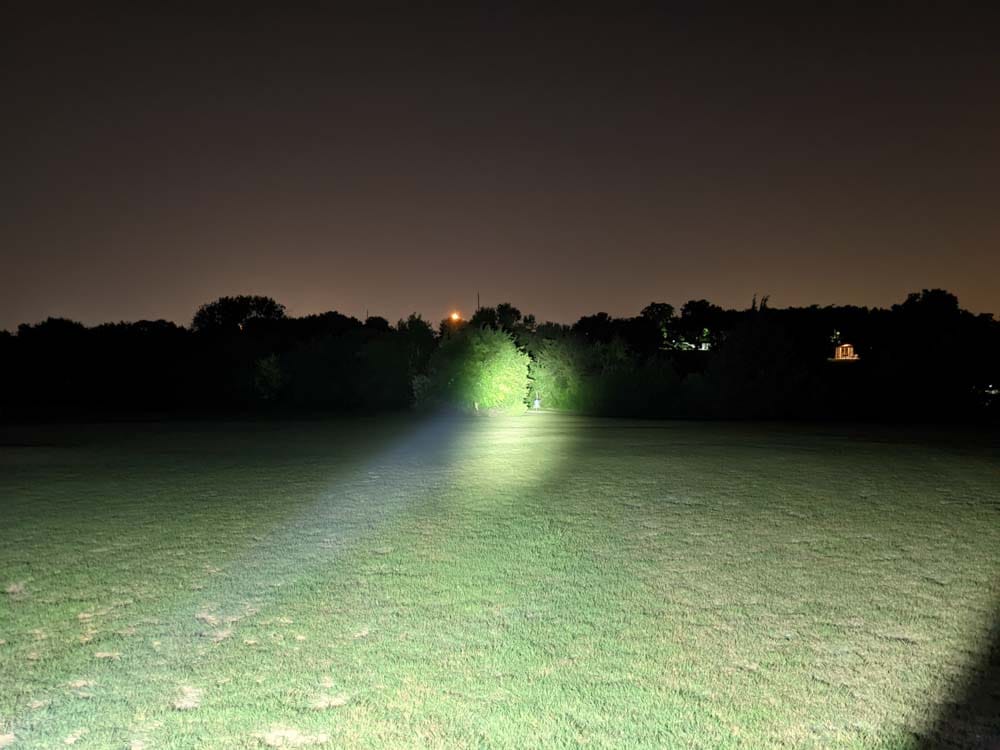


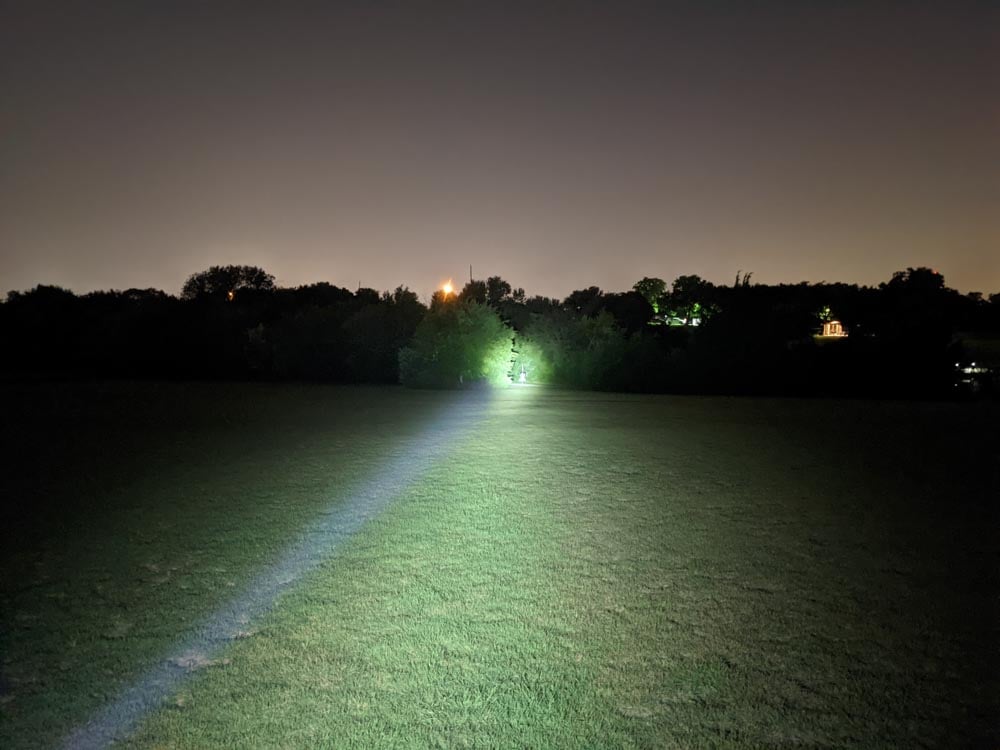

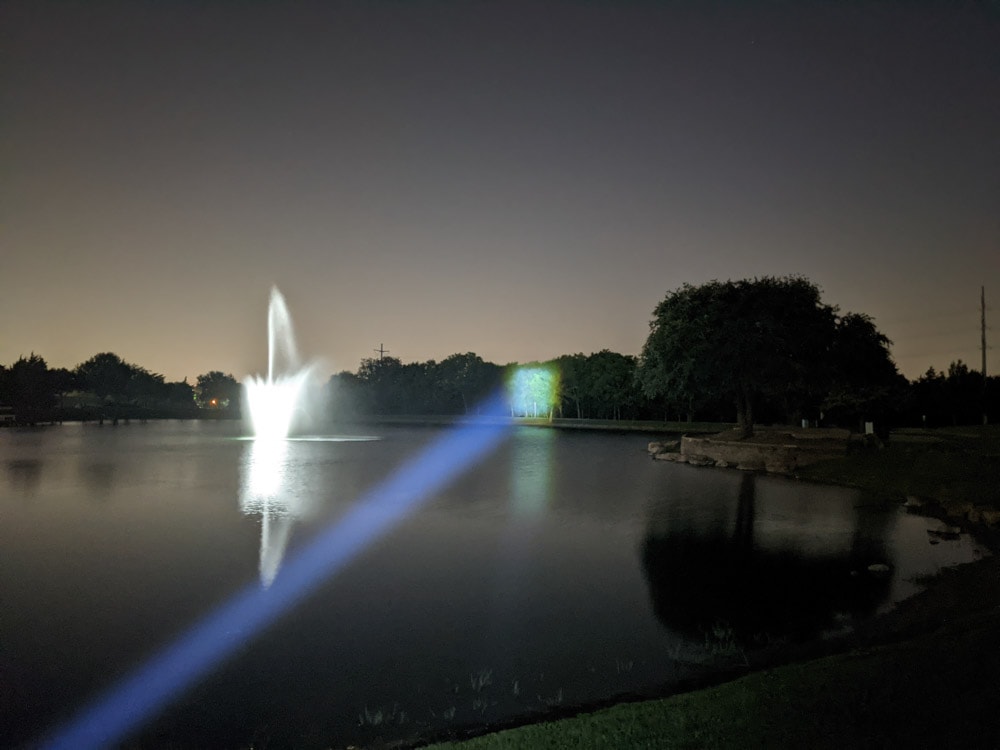


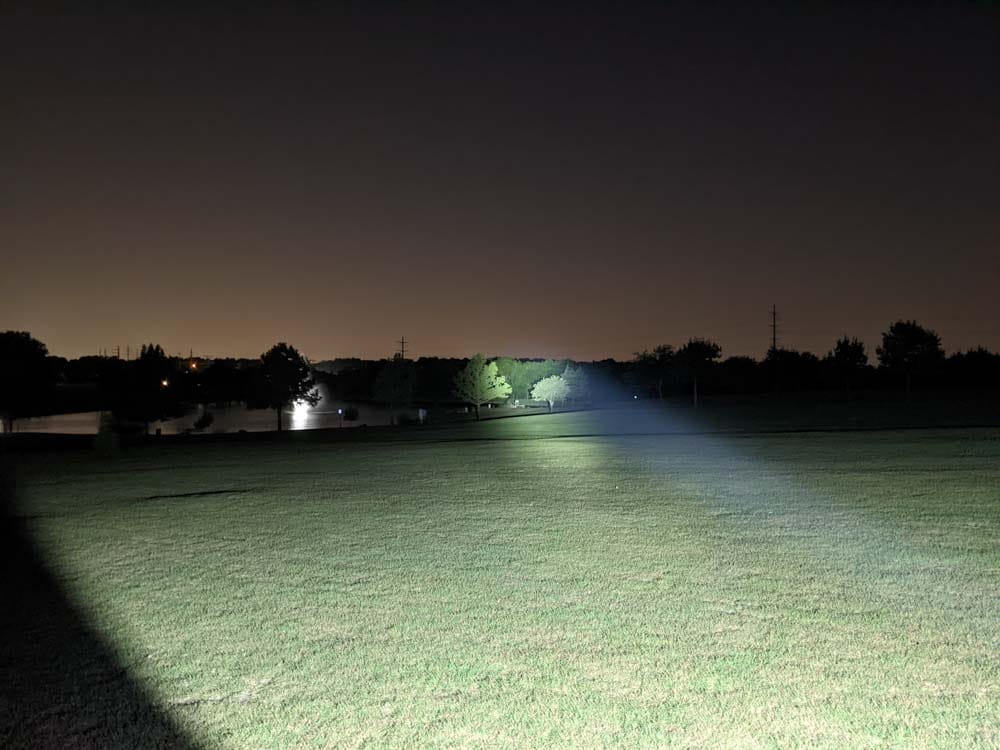
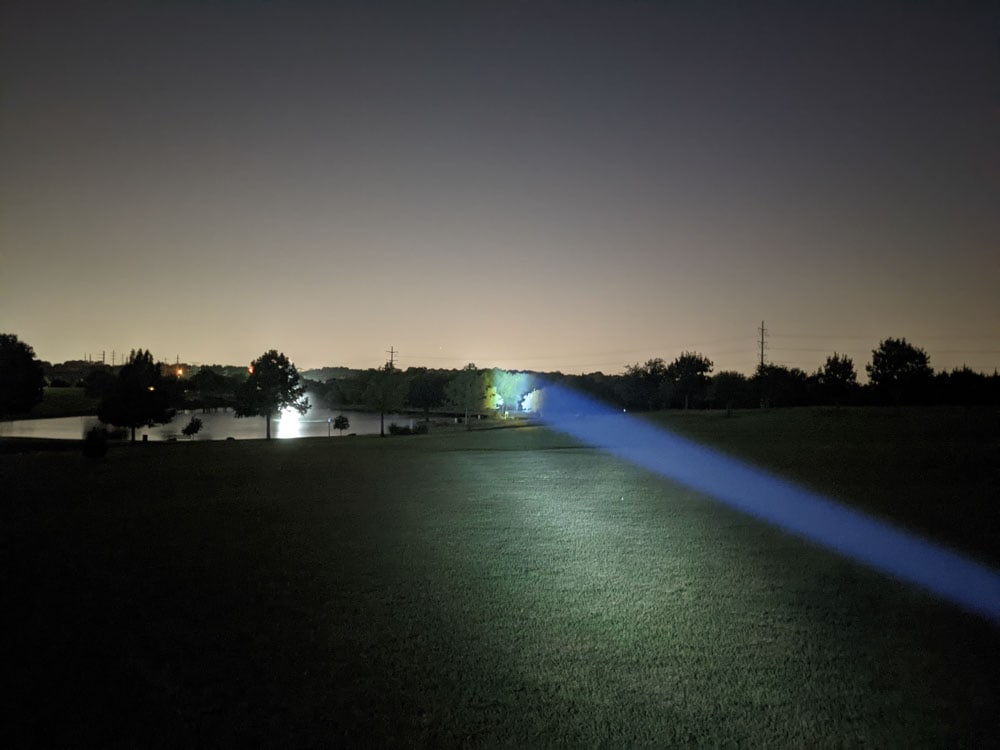


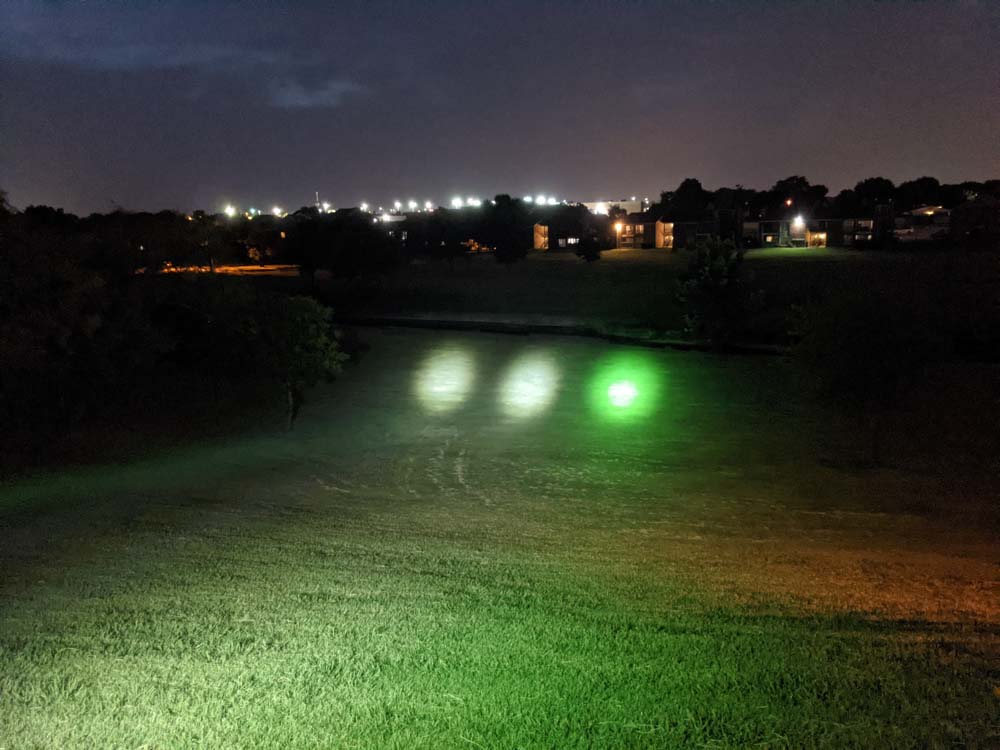
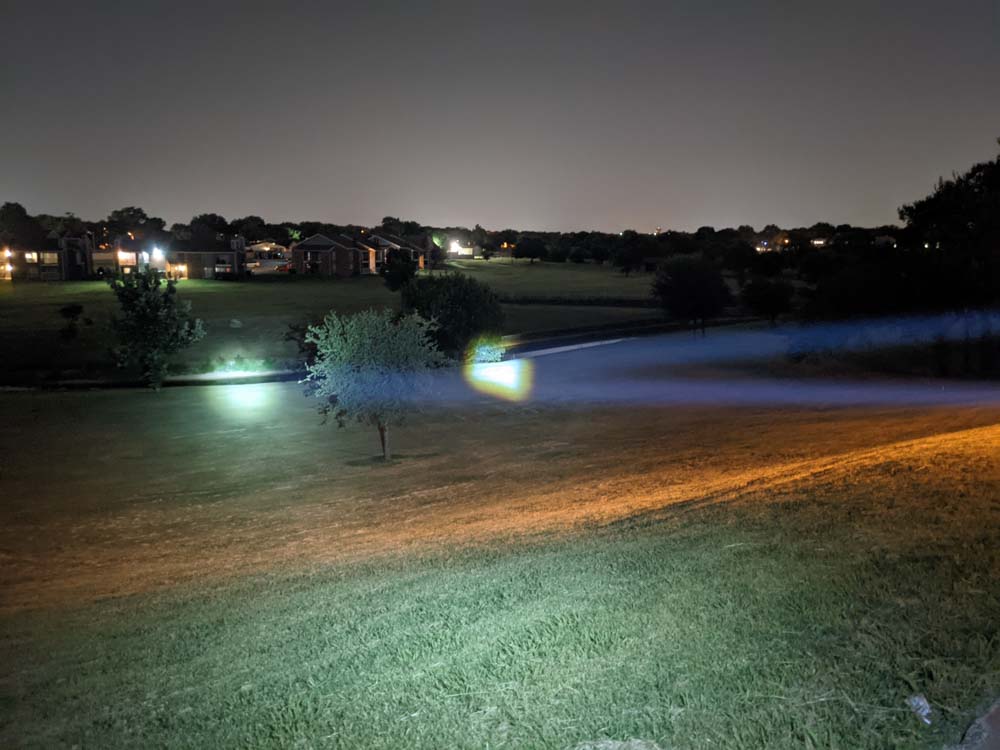
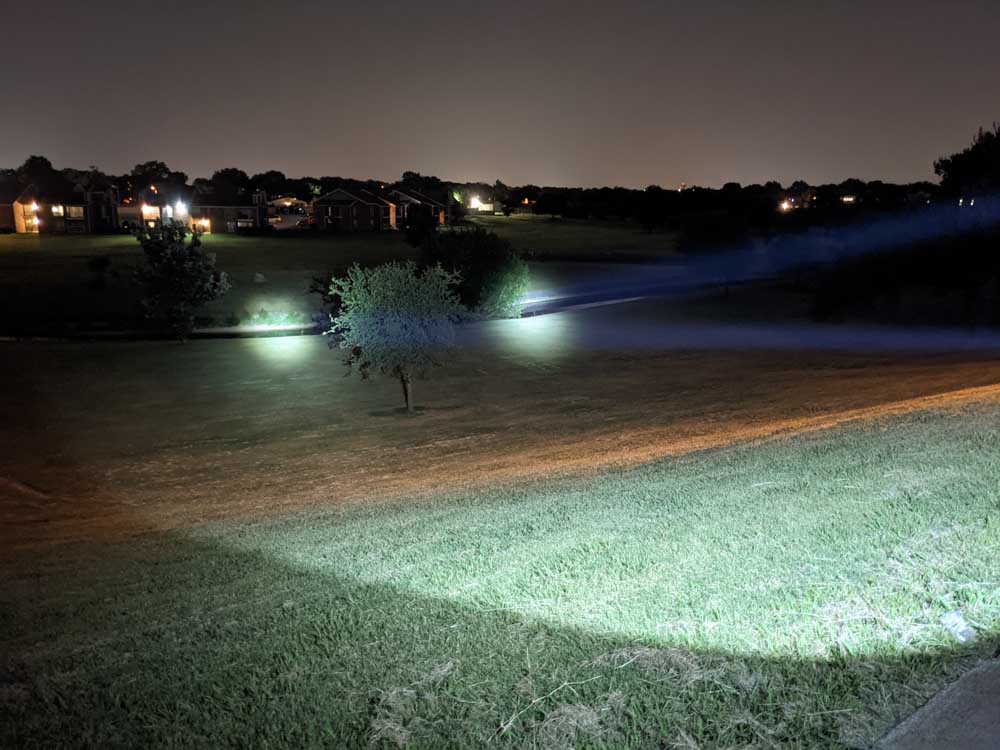
Disclaimer: This flashlight was sent to me for review at no cost by Thrunite. I have not been paid to review, nor have I been holding back on problems or defects.
Final Verdict
Pros
- Compact & lightweight
- Excellent UI
- Does not get hot
- Excellent throw that outperforms the official rating
- Good runtime for an 18350
- Complete package
- Great grey color option
- Unique beam with little spill
Cons
- No pocket clip
- Proprietary battery included (not required)
- No temperature management
- Sustained output could be higher
- C-to-C charging doesn’t work
Explanation on star ratings:
1: Avoid: my phone flashlight would be a better choice – 2: Poor: significant defect or issues, much better options available at the same price – 3: Average: some defects or issues – 4: Good: recommended (minor issues) – 5: Great: highly recommended
Reviewer: Angus
4 stars: ★★★★
I like this light and it’s an excellent addition to the range of compact TIR throwers already available on the market. Thrunite nailed the looks, UI, switch, fit, finish, beam, and size. I particularly like the side switch and use of a more standard 18350 battery, as that combination makes it unique in the compact TIR thrower space. My only significant gripe is the lack of a pocket clip which doesn’t sound like a huge deal, but I found myself missing a clip so much during the review that I have to knock off a star just for that. The Catapult Mini is fun. Overall I rate it a 4 out of 5.
Thrunite Catapult Mini For Sale
1lumen selects and reviews products personally. We may earn affiliate commissions through our links, which help support our testing.